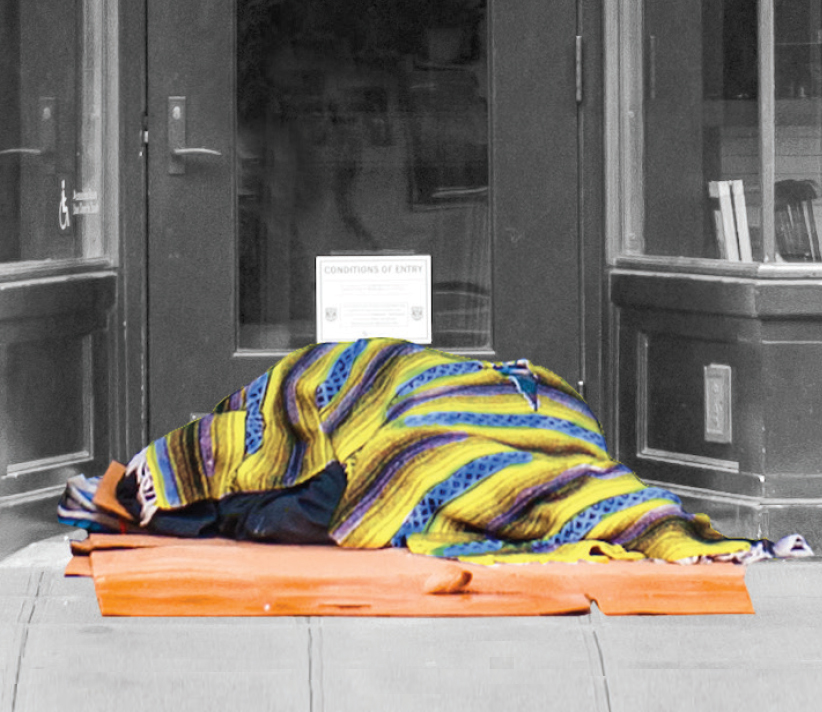Jay T. Morris is a 52-year-old man with a pit bull named Moose and a history of causing headaches along the Seattle waterfront. Earlier this year, Morris and his champagne-colored four-legged friend unwittingly became the poster children for one of several new approaches launched under the Center City Initiative, a program championed by Mayor Mike McGinn as a way to solve Seattle’s problems with street disorder and reduce the number of homeless people on the street.
As police reports and Seattle Police Department’s Sgt. Paul Gracy tell it, Morris made a name on the waterfront as a chronic nuisance, sitting or lying on the sidewalk near Argosy Cruises with his unlicensed canine and a tattered collection of belongings, including blankets and signs. Local business owners came to know and loathe him. The police were called—repeatedly. For months, nothing changed.
“Basically, he blew me off,” remembers Gracy, who says he often had the unenviable task of responding to complaints about Morris. “Finally, we decided that we would have to start giving him citations. . . . He didn’t care.”
It’s not an unusual story.
In Seattle, many of the low-level criminal behaviors associated with chronic homelessness—public urination, open alcohol containers, and violations of the city’s sit/lie ordinance—are civil infractions, punishable by a citation and a fine. The citation for drinking in public, which police say is the most common, carries a $27 penalty. According to Seattle Municipal Court records, in 2012 police issued 551 such citations. Of those, 470 ended up in default—meaning the person on the receiving end never paid or responded.
In other words, the citations don’t work. John Schochet, the deputy chief of staff at the City Attorney’s Office, admits that “There tends to be a pretty low response rate.”
Enter the Center City Initiative (CCI), a city-led effort to find not just common ground between commerce and compassion, but, more important, results when dealing with street disorder, chronic homelessness, and the problems associated with all of the above. Since October, the city has hosted five volunteer roundtable CCI discussions, where roughly 45 “stakeholders”—including social workers from Evergreen Treatment Services and the Downtown Emergency Services Center; business leaders from the Pioneer Square Alliance and the Downtown Seattle Association; advocates from Real Change and the NW Immigrant Rights Project; and law-enforcement officials from the Seattle Police Department, the Department of Corrections, and the City Attorney’s Office—all gather in a big room with the daunting directive of solving a problem that many say is getting out of control. In addition to the full-scale roundtables, a number of smaller workgroups have been created under CCI to study specific problems and report back to the group. The roundtables have been moderated by Dr. Stephen Page of the University of Washington’s Evans School of Public Affairs.
CCI is a pure reflection of Seattle’s love of process.
Of course, this isn’t the first time the problem of homelessness in Seattle and King County has been targeted. The 10-Year Plan to End Homelessness, introduced in March 2005, is currently in year eight, and despite the planners’ best efforts and the Plan’s many real accomplishments, the number of homeless people on the street has remained steady over the past few years (thanks in no small part to the Great Recession and social-services funding cuts at the state and federal level). King County’s Committee to End Homelessness estimates that, over the course of a year, more than 24,000 people in King County will experience an episode of homelessness—the bulk of them in Seattle.
Despite the scale of the problem, however, many involved express sincere hope that this effort will succeed where others have failed. And the way Morris and his pit bull have been dealt with is just one of many compromises, and tenuous agreements between business and social services, that have emerged from the CCI table.
The City Attorney’s Office, under the leadership of Pete Holmes, has historically chosen not to pursue defaulted citations, arguing that to do so would in essence criminalize an infraction considered civil, and, consequently, criminalize poverty itself. When someone fails to respond, the City Attorney has the option to issue an arrest warrant; it just isn’t done. Or wasn’t—until earlier this year, when Morris and his dog pushed the envelope.
In a departure from past procedure, and in direct response to the CCI discussions, Holmes’ office has agreed to file failure-to-respond charges on what’s described as a “case-by-case basis,” allowing for an arrest warrant to be issued when it might prove helpful in dealing with habitual offenders. Last April, Morris received the first one.
Not long after receiving the warrant, police say, Morris left the waterfront and hasn’t been back.
The City Attorney’s Office says it doesn’t anticipate filing charges often, but it will become one of law enforcement’s tools for dealing with chronic street disorder. “We’ve committed to use this model,” says Schochet, of the new approach, which provides teeth to existing city laws. “If more cases are brought to us, we’ll use it.”
“[Morris would] still be down there today if we hadn’t issued the warrant,” says Gracy.
But CCI isn’t about just getting tough on street disorder or dispatching the homeless. Far from it, actually. In an exercise defined by its compromises, Morris’ case represents more a nod of acknowledgment to frustrated business owners and intimidated tourists than an indication of CCI’s philosophical bent. Somewhere, Morris—or someone much like him—is still out there and still needs help. While the concerns of business owners are being listened to and respected, CCI has provided victories for social-services advocates as well. The discussion has gone both ways.
According to Lisa Daugaard—deputy director of the public-defense agency The Defender Association and one of the most respected voices at the CCI table—the big trade-off that has guided CCI so far is straightforward, but new to Seattle: Advocates and social-service providers recognize that people sleeping in doorways, camping in parks, drinking in public, and peeing in alleys makes doing business downtown difficult, while business owners attempt to come to terms with the reality that Seattle can’t solve this multifaceted problem simply through tougher laws.
Nine months into this process—which many have called “unprecedented” for Seattle, thanks to the number of interests drawn into cooperation—CCI is just now beginning to bear tangible fruit for those living on the street and the people fighting on their behalf in City Hall. Mayor Mike McGinn plans to request $1.5 million in funding in his next budget to expand the LEAD (Law Enforcement Assisted Diversion) program throughout the downtown core. A new “Multidisciplinary Team” of law-enforcement officials, social workers, and advocates has been created to help revamp the way the city conducts outreach to homeless and drug-addicted people, taking cues from cities like L.A., San Diego. and Philadelphia. And the city’s Office of Housing is working to free shelter bed space by getting long-term shelter users into more permanent housing.
According to most, however, CCI’s biggest accomplishment so far has been the dialogue and understanding fostered within an entangled community more accustomed to fighting than working together. No longer is the conversation purely business vs. social services. While raw frustrations remain, leaders on both sides say there’s something different about the Center City Initiative.
“In my experience, something like this would have fizzled after three meetings,” says former director of Seattle’s Human Services Department Dannette Smith, who played an integral role in CCI before leaving her post in mid-June to become the human-services director for the city of Virginia Beach, Va. Prior to her appointment by McGinn, Smith served in similar capacities in Georgia, North Carolina, and Chicago. From her 58th-floor corner office—a perch where a Seattleite could practically see every homeless person in the city—Smith described the city as at a “crossroads” in the way it deals with homelessness and street disorder.
“I’ve never seen anything like this,” says Real Change founder and executive director Tim Harris of CCI. “I’m pretty cynical about things, but these meetings have been very inspiring to me.”
Whether they are inspiring is beside the point. Will they work?
The “See It, Send It” campaign launched by Visit Seattle may have been the jolt that made CCI possible.
It started with a letter sent sent by an unnamed tourist to Mayor Mike McGinn and then Police Chief John Diaz last September. “Walking through the smell of human waste, and my 10-year-old son stepping in human feces on the sidewalk, erased the actual beauty of the market,” it read. “I can honestly say I am more afraid of walking in downtown Seattle than Chicago.”
The letter struck a chord with Visit Seattle, a nonprofit tasked with selling the Emerald City to tourists and large-scale conventions. As the letter was getting local press attention, Visit Seattle launched “See It, Send It,” urging business owners and residents to take photos of illegal or unsavory activity downtown and deliver them to city council members and the mayor’s office.
More than just photos emerged. Some images came in narrative form—for instance, the story of “Tom” (name changed), submitted by Jon Scholes, the Downtown Seattle Association’s vice president of advocacy and economic development. His account is based on an e-mail report by the supervisor of the Metropolitan Improvement District’s Safety Ambassadors—those yellow-vest-clad envoys, financed through tax assessments on downtown properties, tasked with maintaining the city’s downtown core. Among other things, MID ambassadors are on the front lines of Seattle’s homelessness and street-disorder problem.
According to Scholes, the story of Tom “details the impacts that one individual is having on the downtown neighborhood, the challenges he’s facing, and the public cost involved.” Tom’s story was later used in an early CCI meeting to illustrate the extent of street-disorder issues downtown.
As far as we can tell, “Tom” has not showered in months, nor has he changed his clothes. He will urinate in his trousers several times a week; literally sitting on the ground and wetting his pants while we are talking to him. He is bright enough to figure out the nuance of what he can get away with in terms of his behavior on the street, yet he walks around wearing several months of his own urine and feces. . . . Business providers are frustrated by his presence and feel that he has a direct negative impact on their business, their staff, and their customers. . . . Opportunities for engagement have been provided to Tom roughly 100 times in the past 30 days by the MID outreach team. Tom is also well known to the service-provider community, who has attempted engagement two times per week since 2008.
“It opened up a dialogue. We did not want it to be a public dialogue, necessarily,” says Visit Seattle President and CEO Tom Norwalk of “See It, Send It.” “We did not want it to be a public debate pitting the hotel industry or retail industry against homelessness.
“We have issues that are complex in the city,” he adds. “How do we address it and get to a point where we do something? . . . Frustration gave birth to ‘See It, Send It.’ ”
Seattle Mayor Mike McGinn has witnessed some of that frustration firsthand, receiving harsh criticism from some corners of the business community for his handling of street disorder and homelessness-related blight. “See It, Send It” was a revelation, laying bare the business community’s deep discontent.
“When the ‘See It, Send It’ campaign came our way, I can tell you my reaction was ‘Oh geez, we’re working so hard on this stuff, and the fact of the matter is we’re seeing really great economic outcomes downtown. We’re seeing a record number of hotel stays, a record number of cruise-ship boardings.’ But then I was, like, ‘OK, well, you know, we’ve got to elevate this even more, invite everyone to the table here and really focus on solutions.”
One month after the letter was sent, the first CCI roundtable was held.
Visit Seattle’s stake in the game is clear. Tourism in King County is a nearly $6-billion-a-year business, with much of that action in downtown Seattle. The city hosts 40 to 45 large-scale conventions a year—events often booked five or 10 years in advance, each pumping from $5 million to $25 million into the tourism economy in a week. Norwalk says competition for these conventions is fierce, and that several meeting planners have said that for them to return to the Emerald City, they’d need to see marked improvement in Seattle’s downtown street disorder. Whether Seattle has ever missed out on a convention because of any of the unsightly activities that fall under the broad term “street disorder” is unclear; Visit Seattle says their agreements with meeting planners bar them from discussing the topic.
So far, however, Norwalk calls CCI “very encouraging.” The Downtown Seattle Association agrees, as does Leslie Smith of the Alliance for Pioneer Square. While not everyone is sold on the idea—it certainly has its critics—the list of businesses and neighborhood organizations that endorse CCI goes on.
Marc Berrier, who bears a resemblance to a heavily tattooed Eddie Vedder, is a 37-year-old homeless man currently housed through the Seattle Union Gospel Mission. Originally from Pennsylvania, he describes his father as the owner of a construction company and his mother as a retired government worker. After studying business marketing and earning a bachelor’s degree from Ohio State, Berrier says he worked for Red Bull as a district manager and later as an East Coast supervisor for Snapple and Dr. Pepper.
Then drinking caught up with him.
“My job really was to take care of customers. Take people out, show them a good time. My drinking just got real bad,” he recalls, sitting at a cafeteria table at the Union Gospel Mission Men’s Shelter. “It got to the point where I woke up in the morning and I had to drink.” Now eight months sober, Berrier rattles off a list of jobs he’s held for short periods in Seattle, all eventually thwarted by his drinking.
He’s not alone. According to the 2013 One-Night Count, 1,989 individuals were found living unsheltered outside in Seattle—equaling nearly 73 percent of King County’s shelterless population. Of them, 194 were found under roadways, 139 in doorways, 69 in bushes or undergrowth, and 257 simply “walking around.” County-wide, 8,830 homeless individuals were identified during the One-Night Count, with 6,236 found in shelters or transitional housing. The rest were on the street.
Berrier, who sees the many misconceptions people have about those living on the street, says he ended up in Seattle after first becoming homeless in Las Vegas. He picked the Emerald City on a whim. “I didn’t have anything. A case worker had given me a backpack and a four-pack of Ensure,” he remembers. “I don’t really know what happened. I got pretty messed up on the bus. I woke up at Harborview. . . . They gave me a place to stay at DESC.
“The next day I went and wandered around the city.”
With a college degree and a middle-class upbringing, Berrier doesn’t fit the stereotype. But that’s just the thing, according to Union Gospel Mission Special Projects Director Mike Johnson: The conversation of homelessness is one in which we too often fail to see people for who they actually are. “There’s a deep level of personal brokenness, relational brokenness; people who don’t know how to work with themselves or others or the world around them. They’re adrift,” says Johnson of those living on Seattle’s streets. “What I would hope is that we wouldn’t just find some new tools, but that we would find a better narrative. And I think CCI is a step in the right direction.
“[Previous efforts to end homelessness] have all been about, ‘Let’s create all these resources,’ the narrative being ‘People need resources, and want resources, and they need help, and if you made the resources, people could access them and get better.’ . . . Now we’re realizing that it’s not just a lack of resources.”
This assessment seems backed up by Berrier’s experience, which eventually landed him in the year-long program offered by the Mission. “If you had to be homeless anywhere, it’d be here. . . . You can eat 10 times before noon, just in this area. If you go hungry in Seattle because you’re homeless, you just want to,” he says of the Emerald City’s compassion.
“People think that the homeless aren’t trying. Or they think that everyone’s just a drug addict that doesn’t want help,” he says. “I mean, I am an alcoholic, but I gave that up to work to try to get out. That’s a huge misconception. It’s just how the cookie crumbled for me.”
Sitting on an expensive couch inside Dania, the upscale furniture store on Western Avenue that she’s managed for eight years, Lisa Grimbly, who hasn’t been part of the official CCI discussions, looks out the window, sees the street, and thinks about the roughly 30 homeless people who once camped outside her store every night. Though she says things have improved on her block over the past several months, she still sounds skeptical—visions of used needles and the smell of human waste fresh in her mind—when discussing the city’s efforts to tackle its homeless problem.
“We’re not bashing the homeless,” she says emphatically, making sure to stress the point. “But some of it is getting out of control. . . . My concern is that there’s not going to be any mother walking by with her children if she wants to come visit our shops.”
Like many business owners, Grimbly says she wants the homeless to get the help they need. But she’d also like to see the city strengthen its regulation of the generally unenforced laws against sitting and lying during daytime hours, panhandling, open containers, and public urination. In essence, she’d like to see more of the constant troublemakers get the Jay T. Morris treatment, and believes the city still has a long way to go on this front. “I know it sounds kind of backwards, but it’s not working being so lenient,” she contends. “Actually, it’s attracting more of the people that are misplaced and homeless.”
Grimbly isn’t the only person who has called for strengthening laws aimed at reducing homelessness’ unsightly aspects. Most recently, in 2010 Seattle City Councilmember Tim Burgess proposed an aggressive panhandling bill that was eventually vetoed by McGinn. Historically, such efforts in Seattle have done little more than start arguments.
Kate Joncas, president and CEO of the Downtown Seattle Association, says CCI is helping move the conversation forward. “I think we’re just all very frustrated with what the street-disorder conditions can be in the downtown neighborhoods,” says Joncas, who is widely credited by those in CCI with helping to hold together the business leaders involved. “For many years, we all would point fingers. . . . Instead of going that way, [with CCI] we all said, ‘Look, it’s our problem, as a neighborhood. We all share it.’
“It sounds kind of simple, but it enabled us to start having a conversation [that wasn’t happening before],” Joncas continues. “We can now admit the truth of the matter.”
That’s not to say that everyone is thrilled. While folks like Joncas and Norwalk credit the mayor for starting the conversation and credit the city for trying a new approach to what feels like an age-old problem, in other parts of Seattle, frustration nears the boiling point. In Pioneer Square, for instance, which roughly 2,100 residents call home—1,200 of them in a shelter bed or some form of transitional housing, according to numbers provided by the Alliance for Pioneer Square—Shari Druckman-Roberts sees the people hanging out in Occidental Park and speaks with anger in her voice. Not part of the CCI discussions, the owner of From the Heart Pottery since 2006 remains skeptical of approaches to solving the homelessness problem based on offering more services. “These people should not be on the street. They should not be allowed to sleep in the street. They should not be allowed to be out in public with mental disorders, if they have them, or if they’re drug addicts, they need to go away,” she says. “People like us are going to get angrier and angrier, and without the proper police support, we’re going to start to take things into our own hands. Which means people are going to get hosed down.
“Like, if I was Dania, I’d hook up a hose and hose all [the homeless people] down in the morning,” she continues. “What kind of humanity is that?”
A native New Yorker, Druckman-Roberts says she’d like to see an approach similar to the get-tough efforts on homelessness that made headlines there in the late ’90s, when Mayor Rudy Giuliani famously cracked down on street disorder by ordering all “able-bodied” homeless people to work in exchange for city-provided shelter and services—going as far as to threaten the homeless with the prospect of losing their children to foster care. While critics have debated how much credit these get-tough measures should get, if any, Druckman-Roberts points to the Toys R Us that’s now in Times Square and says a similar tactic is needed in Seattle. “I’m against a lot of the entitlements that enable people to remain victims. That’s what the problem is. Everyone wants to do good, but they’re not doing good. They’re not helping anybody,” she says. “Seattle’s allowing people to sleep and defecate and God only knows what else in the streets. It’s a humiliation for both sides.
“We need to hire a new mayor,” she concludes.
Seattle Mayor Mike McGinn leans back in his chair in a windowless room in the back of his International District campaign office. Locked in a fierce re-election battle, he turns his attention to homelessness and street disorder, a topic familiar to him.
A few nights prior, at a mayoral forum sponsored by the Seattle Chamber of Commerce, McGinn had vigorously defended his record in dealing with these problems. It wasn’t the first time he’d been put on the spot. In this campaign season, the mayor has earned a reputation for holding a horn-tooting press conference for even the most trivial administration accomplishments. Though he hasn’t yet done so for CCI, when pressed on the topic of street disorder, pointing to CCI has become his standard response. Whether that response is resonating, however, is another matter. Two weeks after the forum, citing downtown safety as one reason, the Chamber of Commerce officially endorsed one of McGinn’s many challengers, state Sen. Ed Murray.
“Other people can judge. I can tell you what we’ve done,” a reflective McGinn says of his administration’s record on homelessness and street disorder. “We have serious issues in this city right now, and we want to address those issues.”
“We’re bringing everyone together,” he says of CCI, an effort he’s largely credited with spearheading. “We have to do it in a way that doesn’t get us back to the open political warfare on the issue. Because then everyone retreats to their camps, and nobody is listening.”
McGinn will be counting on people like Seattle Police West Precinct Captain Jim Dermody. The lifelong Seattleite and second-generation Emerald City cop is known for his love of data. When Dermody, who holds an executive master’s degree from UW’s Evans School, sees Seattle’s troubles with homelessness and street disorder, he looks to science to guide him. He’s been on the job in the West Precinct roughly 14 months, after being transferred downtown from the East Precinct in May 2012.
One thing that gives Dermody hope is the forthcoming effort to expand LEAD (Law Enforcement Assisted Diversion) throughout the downtown core—an idea birthed at the CCI table. With the mayor’s office preparing a budget request to put $1.5 million on the table in 2014 for the program, the expansion would allow officers throughout downtown to work with a recently formed Multidisciplinary Team of outreach workers, MID ambassadors, DOC officials, and advocates to target chronic offenders, offering intensive social-service outreach and intervention instead of jail stays.
LEAD is already used in Belltown, its cross-hairs on drug and prostitution offenders. Although tweaks may be made to allow for the handling of other street-disorder-related offenses, officials believe the program has been successful enough in getting habitual offenders into services and out of the low-level criminal loop to warrant its expansion. According to Lisa Daugaard—who helped orchestrate LEAD’s rollout in Belltown via nearly $1 million in private grants, and who has also been involved in planning the program’s downtown expansion—the $1.5 million will go toward staffing and the purchase of wrap-around services like drug and alcohol treatment, mental-health services, and housing for as many chronic offenders as possible. She says the figure was decided upon “based on the approximate cost of providing services so far for the volume of people we’ve served in Belltown, and then expanding by that ratio for the rest of downtown.”
“Anecdotally, we know there are folks [in Belltown] receiving services through LEAD that are not out re-offending,” says Dermody, who would welcome the program’s expansion.
The newly established Multidisciplinary Team will attempt and monitor targeted outreach to a specific list of chronic offenders—an approach that’s seen success in other cities. Daugaard estimates the list will eventually include a little over 100 names, and though she admits some reservations about directing the city’s limited resources toward a group that’s targeted largely for their business-nuisance factor, she says the savings made possible by these efficiencies will allow, overall, for more of Seattle’s homeless to get the help they deserve.
On the other side of the coin, Dermody is up-front about law enforcement’s limitations in handling all the issues related to homelessness and street disorder, saying there’s no way Seattle can “arrest its way out of these problems.” He’s shared these challenges at the CCI table. “The main complaints I hear from stakeholders downtown are about the open-air drug selling and drug use and the impact of the homeless issues,” he says, noting that the bulk of King County’s social services are located in four square miles of downtown Seattle.
“Seattle is a service-rich city. We are known in some places as Free-attle,” he says. “We have that reputation.”
Dermody sees the magnitude of the problem, but that’s not to say he believes it’s insurmountable. Championing a science-based approach also launched under the CCI umbrella, targeting downtown’s crime “hot spots”—areas with established high levels of low-level criminal activity—the captain is adamant that progress can be made. True to form, he points to data when describing the progress so far. He says that 911 calls in the downtown core are down across the board, and major crimes were down 15 percent in January–May 2013 from the same period in 2012. Property crimes dropped 15 percent in the West Precinct over the same span, with 900 fewer thefts than last year. The major crime total for May in the West Precinct was the lowest for that month in six years. There was also a 9 percent reduction in violent crimes, with a 16 percent drop in robbery and a 5 percent drop in aggravated assaults.
“The message is we’re headed in the right direction,” the captain says of the trends and the impact CCI has provided.
Lisa Daugaard’s office, in the unassuming downtown home of The Defender Association, is a mess. She says she hopes to clean it someday—perhaps filing away the stacks of paperwork that occupy nearly every bit of open desk and table space—but the likelihood of that is slim. In a corner, propped against a wall, is a poster from Daugaard’s time working on homeless issues in New York. The picture of a cop in full riot gear is captioned: “RUDY GIULIANI’S IDEA OF A SOCIAL WORKER.”
Given her role as an advocate for the poor and homeless, Daugaard’s response to the hard-line positions of people like Druckman-Roberts could be seen as surprising. “That pushes all the triggers. In the past, the reaction [from the social-services and advocate community] would have been, ‘That’s wrong and misguided and needs to be opposed,’ ” Daugaard says. “The CCI conversation is different,” she claims, because the sentiments of business owners who just want to see the homeless stop sleeping in front of their storefronts is “actually a pretty strong consensus view. It isn’t optimal for people to be living on the street. Very few people in the conversation really want this to be a conversation about whether people have a right to live on the sidewalk.”
That’s a new stance for folks like Daugaard—one of many fostered by CCI. “From a civil-liberties standpoint, [the CCI conversations have meant] that those of us who advocate for the rights of poor people are not fighting for the right of people to live on the sidewalk. I will fight for the right for people to live undisturbed on the sidewalk unless we’re offering them an alternative; we’re saying that’s not the main conversation; we’re saying let’s have a conversation that’s the alternative,” says Daugaard. “That’s a big leap of faith.” She estimates that 80 percent of Seattle’s homelessness and street-disorder problems stem from a social-services and human-services gap.
But while Daugaard exudes hope, others remain skeptical—the main issue being money, for good reason.
Real Change’s Harris describes Downtown Emergency Services Center Executive Director Bill Hobson, also a key member of the CCI discussions, as an “unofficial spokesperson for the human-services tribe.” As Harris points out, during his three-decade career Hobson has seen everything when it comes to grappling with the problems associated with homelessness in Seattle. Through repeated heavy sighs and a bit of chewing tobacco in his lower lip to take the edge off, Hobson talks about the reality of what something like CCI can accomplish, given the shortage of resources and the constantly shrinking state social-services budget (Amnon Shoenfeld of the King County Mental Health, Chemical Abuse and Dependency Services Division says state funding for mental-health and substance-abuse programs has decreased by “well over $20 million” in the past four years).
“The problem with outreach, to be successful, you have to have resources to bring people to,” Hobson says. “You have to have, at least initially, an emergency shelter to bring people to; you have to have permanent housing to bring people to. We don’t have that; all of our shelters are full, because there’s not enough available permanent support of housing to bring people to. [CCI isn’t] getting into that.”
According to King County’s Committee to End Homelessness, in 2012 roughly 2,583 shelter beds were available, with 92 percent of those in Seattle. Seattle’s Office of Housing has been involved in the construction of more than 50 new housing projects since 2002 that support the 10-Year Plan, providing 2,229 units for formerly homeless people. In 2012, Seattle provided $32.4 million in funding for shelters and drug and alcohol treatment, despite dwindling money from the state and federal government. In the adopted budget for 2013, about $50 million is allocated for shelters, drug and alcohol treatment, and housing.
Still, Hobson says it’s far from enough. And without a much bigger investment, he argues, the outreach efforts launched under CCI will go only so far. “The permanent solution is permanent housing for this population. And I don’t see a whole lot of hope for that situation,” says Hobson. “I see CCI not grappling with that larger issue. It’s too big. It’s too onerous. And so we come down here and think we can deal with it with services. Which to a limited degree we can, but it’s only a limited degree.”
Marc Berrier, who credits much of his drinking to “a personal sense of failure,” says he’s hopeful about his future. He’d like to get back into sales someday. Recently he climbed to the summit of Mt. Hood with a team of his Union Gospel alums; there are plans to take Rainier this summer.
As for the future, Berrier admits, “There’s no telling what’s going to happen to me once I get out of here . . . It’s something that I’m going to have to deal with for the rest of my life,” he says of his alcoholism. “And that sucks.”
When told that city and business leaders, advocates, and law-enforcement officials have been gathering for nine months to come up with a plan to help people get off the streets for good, Berrier has one simple response: “How?”
That’s the million-dollar question. Only time will tell if CCI is able to provide an answer.










